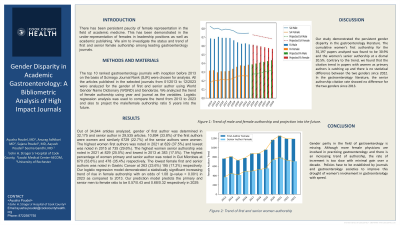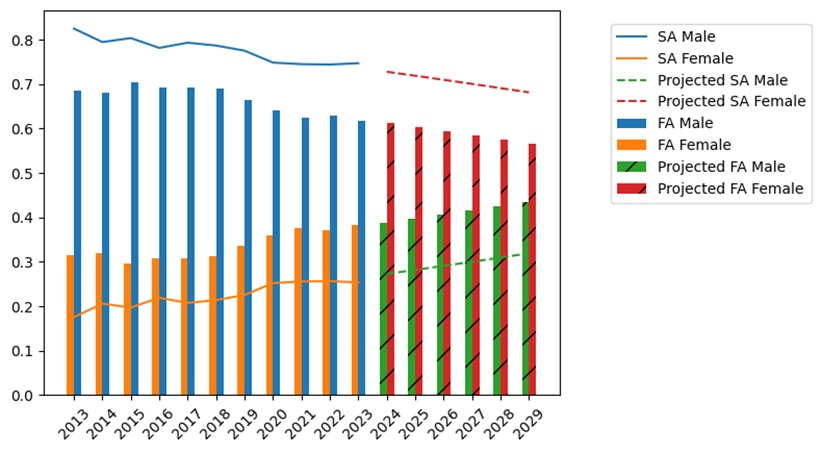Sunday Poster Session
Category: Practice Management
P1492 - Gender Disparity in Academic Gastroenterology: A Bibliometric Analysis of High Impact Journals
Sunday, October 27, 2024
3:30 PM - 7:00 PM ET
Location: Exhibit Hall E

Has Audio

Ayusha Poudel, MD
Cook County Health
Chicago, IL
Presenting Author(s)
Ayusha Poudel, MD1, Anurag Adhikari, MD2, Sajana Poudel, MD3, Aayush Poudel, BSc4, Seema Gandhi, MD3
1Cook County Health, Chicago, IL; 2NYC Health + Hospitals/Jacobi, New York, NY; 3John H. Stroger, Jr. Hospital of Cook County, Chicago, IL; 4University of Rochester, Charlotte, NC
Introduction: There has been persistent paucity of female representation in the field of academic medicine. This has been demonstrated in the under-representation of females in leadership positions as well as academic publishing. We aim to investigate the status and trend of first and senior female authorship among leading gastroenterology journals.
Methods: The top 10 ranked gastroenterology journals with inception before 2013 on the basis of Scimago Journal Rank (SJR) were chosen for analysis. All the articles published in the selected journals from 01/2013 to 12/2023 were analyzed for the gender of first and senior author using World Gender Name Dictionary (WGND) and Genderize. We analyzed the trend of female authorship using year and journal as the variables. Logistic regression analysis was used to compare the trend from 2013 to 2023 and also to project the male/female authorship ratio 5 years into the future.
Results: Out of 34,644 articles analyzed, gender of first author was determined in 32,175 and senior author in 29,535 articles. 10,894 (33.8%) of the first authors were women and similarly 6729 (22.7%) of the senior authors were women. The highest women first authors was noted in 2021 at 829 (37.5%) and lowest was noted in 2015 at 735 (29.6%). The highest women senior authorship was noted in 2021 at 829 (25.5%) and lowest in 2013 at 383 (17.5%). The highest percentage of women primary and senior author was noted in Gut Microbes at 670 (53.6%) and 478 (35.4%) respectively. The lowest female first and senior authors was noted in Gastric Cancer at 263 (23.6%) 195 (17.2%) respectively. Our logistic regression model demonstrated a statistically significant increasing trend of rise in female authorship with an odds of 1.08 (p-value < 0.001) in 2023 as compared to 2013. Our prediction model predicts the primary and senior men to female ratio to be 0.57/0.43 and 0.68/0.32 respectively in 2029.
Discussion: There is persistent gender disparity among male and female authorship in gastroenterology journals. Though there has been a slow rise among female representation in terms of primary and senior authorship, the rate of rise is slow.

Disclosures:
Ayusha Poudel, MD1, Anurag Adhikari, MD2, Sajana Poudel, MD3, Aayush Poudel, BSc4, Seema Gandhi, MD3. P1492 - Gender Disparity in Academic Gastroenterology: A Bibliometric Analysis of High Impact Journals, ACG 2024 Annual Scientific Meeting Abstracts. Philadelphia, PA: American College of Gastroenterology.
1Cook County Health, Chicago, IL; 2NYC Health + Hospitals/Jacobi, New York, NY; 3John H. Stroger, Jr. Hospital of Cook County, Chicago, IL; 4University of Rochester, Charlotte, NC
Introduction: There has been persistent paucity of female representation in the field of academic medicine. This has been demonstrated in the under-representation of females in leadership positions as well as academic publishing. We aim to investigate the status and trend of first and senior female authorship among leading gastroenterology journals.
Methods: The top 10 ranked gastroenterology journals with inception before 2013 on the basis of Scimago Journal Rank (SJR) were chosen for analysis. All the articles published in the selected journals from 01/2013 to 12/2023 were analyzed for the gender of first and senior author using World Gender Name Dictionary (WGND) and Genderize. We analyzed the trend of female authorship using year and journal as the variables. Logistic regression analysis was used to compare the trend from 2013 to 2023 and also to project the male/female authorship ratio 5 years into the future.
Results: Out of 34,644 articles analyzed, gender of first author was determined in 32,175 and senior author in 29,535 articles. 10,894 (33.8%) of the first authors were women and similarly 6729 (22.7%) of the senior authors were women. The highest women first authors was noted in 2021 at 829 (37.5%) and lowest was noted in 2015 at 735 (29.6%). The highest women senior authorship was noted in 2021 at 829 (25.5%) and lowest in 2013 at 383 (17.5%). The highest percentage of women primary and senior author was noted in Gut Microbes at 670 (53.6%) and 478 (35.4%) respectively. The lowest female first and senior authors was noted in Gastric Cancer at 263 (23.6%) 195 (17.2%) respectively. Our logistic regression model demonstrated a statistically significant increasing trend of rise in female authorship with an odds of 1.08 (p-value < 0.001) in 2023 as compared to 2013. Our prediction model predicts the primary and senior men to female ratio to be 0.57/0.43 and 0.68/0.32 respectively in 2029.
Discussion: There is persistent gender disparity among male and female authorship in gastroenterology journals. Though there has been a slow rise among female representation in terms of primary and senior authorship, the rate of rise is slow.

Figure: Trend of male and female authorship and projection into the future.
Disclosures:
Ayusha Poudel indicated no relevant financial relationships.
Anurag Adhikari indicated no relevant financial relationships.
Sajana Poudel indicated no relevant financial relationships.
Aayush Poudel indicated no relevant financial relationships.
Seema Gandhi indicated no relevant financial relationships.
Ayusha Poudel, MD1, Anurag Adhikari, MD2, Sajana Poudel, MD3, Aayush Poudel, BSc4, Seema Gandhi, MD3. P1492 - Gender Disparity in Academic Gastroenterology: A Bibliometric Analysis of High Impact Journals, ACG 2024 Annual Scientific Meeting Abstracts. Philadelphia, PA: American College of Gastroenterology.
